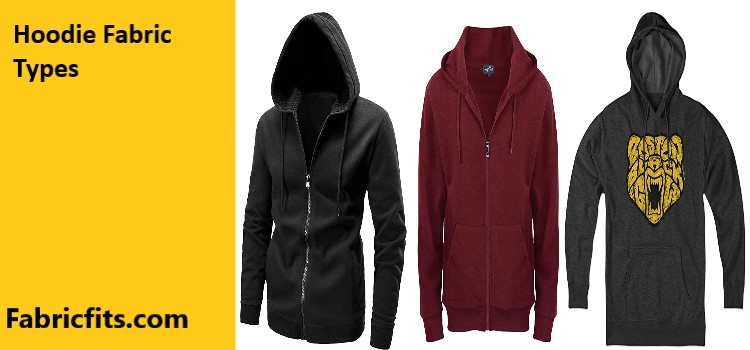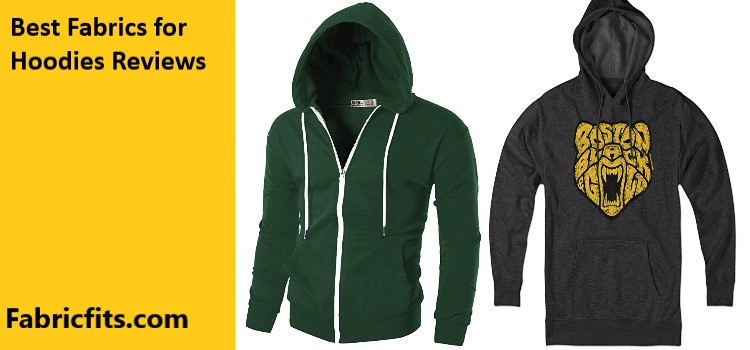Do we really notice the fabric used in the hoodies unless it is for buying purposes? I will choose something lightweight to warm my neck and body, but what material is that exactly?

It matters significantly when you are the one wielding the wand for DIY hoodie additions. So, what is the best fabric for hoodies to go with your wardrobe collection?
It is all about finding one’s comfort zone, and fleece provides that warmth without suffocating you. Other fabric types include cotton, sweatshirt knit, wool, jersey, rayon, etc. The point is to consider your lifestyle before selecting the kind to match your physical activities.
I have more to tell you regarding the subject; care to take a seat, please?
Table of Contents
Hoodie Fabric Types
Most trendy designs for sweatshirts or hoodies these days offer versatile possibilities. Aside from that, one person can have more than one selection of fabric materials.

What do you do then? How do you decide which is comfy, budget-friendly, or to your taste?
Let me tell you the most common fabric types used to make this lovely clothing item.
- Fleece should be the top of all options!
- Jersey hoodies are quite modish in sportswear.
- Cotton versions are also hip and in popular demand.
- My closet consists of a bunch of French terry hoodies; they are surprisingly breathable.
- I also own a polyester hoodie for rainy days.
- Rayon is also a sound choice for lightweight off-season or gym wear.
- Sweatshirt knit can be made of other fabrics but in knitted form.
- I once gifted my father a wool hoodie. He still takes it out every winter to wear under a jacket. And he says it is the best durable present he ever had!
Whether you design it yourself or simply seek guidance for the right material for your style or skin, determining the best narrows down your decision.
What Is the Best Material for Hoodies?
So what if you wanted to rank the material type from high grade to mid-level? I ignored mentioning low quality because none of the fabrics stated here are, in any way, cheap.

It depends on the individual’s personal choice, convenience, and contentment. In that sense, the majority of the votes will lean toward Fleece, then French terry, Cotton, and Jersey, followed by the rest.
The fabric that, in your opinion, allows you to breathe during activities should be on your top list.
Where to Buy Hoodie Fabric?
During the pandemic period, online marketing took over the physical shops quite literally. Therefore, you will find everything from a needle to a sewing machine on sites like Amazon.

Just make sure it is the fabric, not a ready-to-wear hoodie you add to your cart. Some sellers can be vague with such information. So, research well before paying for the items.
Similarly, you can search on Google for nearby stores in your neighborhood for the specific fabric you are hunting.
In short, you can obtain hoodie fabrics by both means. There are thousands of color assortments to pick from. So take your time in market research if the hoodies are for a project.
What to Check When Buying the Best Materials for Hoodies?
Custom hoodies are more fun to make, especially if it is for a group of friends. We have all done that at one point in life, donning the hooded garment to stand apart from the rest.

But how do you characterize the hoodie fabric to achieve precise measurement? Which one will age well, and what will make it lighter or weighty?
Size
The experts call it stretch because hoodies tend to come in a single size. This is why they are generally made loose and flexible for casual wear.
As a result, you have to remember not to make a fitting measurement of the body but a rough accuracy. It will allow the person to wear it without feeling the fabric clinging to the skin.
On the other hand, ensure the fabric offers slight stretch even if you choose to make variable sizes. It helps gain that added coziness.
Notice that most hoodie brands pick stretchable fabrics, especially in the sportswear sector. Take an idea from the professional custom hoodie makers for proper fabric use; they will be more than happy to assist!
Drape or Fitting
What exactly is a drape? Do not confuse it with curtain drapes, though the implication loosely remains similar.
Drape indicates the hoodie fabric hanging casually around your body. A fabric that is stiff and makes you shift from side to side uncomfortably is not worth getting. The hoodie should be in the rhythm of the body’s movement.
You will not have to pat on all over to settle the fabric whenever you sit or hunch down to pick something.
In short, it will complement your style without making you self-conscious.
Furthermore, make sure the material withstands regular washing. It will alter the draping for better or worse if not cared for properly.
Weight
I cannot wear heavy clothing despite the cold weather. It restricts my breathing comfort, stifling me when I should be warm in my downtime.
Many individuals share my discomfort. So it is up to you to choose a fabric that does not stifle the comfort garment but unwinds the heart and soul to relax.
You must pick something light and flexible. When custom-making the hoodies for the first time, winter hoodies should be a little thick. But casual wear, sports, reunion or gathering, or office wear should be lightweight, like cotton.
However, none of the options should be too bulky.
The 8 Best Fabrics for Hoodies Reviews
Without further ado, let me show you which textile materials have contended to stay on the top eight charts. You can opt for pure fabric or go with a blended style to make something unique and cozy to wear. The choice is all yours!

1. Fleece
Once I got this fleece hoodie as an experiment, I now wear it every winter. It is unbelievably soft and lovely – something that does not shrink/stretch after washing.
The fleece hoodie is my comfort garment at home when I do not care what I eat or where I sit. It is more breathable than any synthetic fabric I have come across.
Plus, the fabric offers variable weights. Mine is on the lighter side, with easy cover-ups during summer as well. You can pick the heavy versions for winter wear too.
Unfortunately, it does not retain heat much, so better put on something underneath and over the fleece hoodie before heading out on a winter day.
2. Jersey
Expect additional stretchiness to this fabric when sewing it for a hoodie. People wear jersey knit hoodies during jogging because of the elastic feature.
The fabric is made from a blend of cotton and spandex or polyester. My hands are on polyester blend as it is more stable than the former. I suggest making a close-fitting hoodie when using jersey knit.
3. Polyester
If the individual does not wear it for strenuous activity, polyester will make a lovely hoodie for casual wear. It is smooth and soft as long as you make a loose fit.
However, the synthetic fabric is not breathable; the person might feel clammy and see sweat forming if worn for a long time.
It is suitable for rainy weather, though.
4. Cotton
Nothing feels better than cotton with no additives. It means a lightweight feel, gentle to the skin, and that down-to-earth drape. Remember that the drape amount relies on the cotton fiber knit or weave quantity.
If you plan to make hoodies for children, 100% cotton is the perfect option. It will allow their skin to breathe, unlike synthetic ones that fail to regulate inner temperature.
5. French Terry
You may know it as terry cloth used for making soft towels. One side has a soft pile, whereas the other side consists of loops. You have to keep the soft pile surface inward when making a hoodie.
It delivers a plush feel to the body. French terry is also a version of cotton fabric that comprise stretch and non-stretch options.
6. Sweatshirt Knit
The sweatshirt knit or fabric is specifically for hoodies or sweatshirts with a hood. It has a knitted look with a brushed surface on the reverse.
You can sew and care for it without going through much. There can be cotton or synthetic blend fabrics, so consult before buying the fabric.
Its stretch level is up to moderate, but the loose fitting will give the person a roomy feel.
7. Rayon
I prefer rayon for its breathable and moisture-absorbing quality despite its semi-synthetic construction. As a result, it will not form any mold.
It is better to blend it with other synthetic fabrics for a superior outcome on sporty hoodies.
8. Wool
It is more about traditional and often overlooked hoodie fabrics. I believe it is due to the scratchy irritation many individuals experience.
Nevertheless, it is highly resistant to water, fire, and the usual wear and tear. I recommend picking a wool-blended fabric instead.
Although lightweight and warm, the wool fabric can alter the garment’s shape upon washing.
Is Polyester Good for Hoodies?
You have to know that it is synthetic, meaning a man-made fabric that is quite useful in various seasons. 100% polyester indicates total control of petroleum-based plastic threads, which are transformed into fibers to make the fabric.
Does that mean you wear a plastic hoodie when choosing polyester? To be blunt, yes, but it is more than that.
Thanks to this option, you achieve a windbreaker-style hoodie too. It will not wrinkle, stain, or absorb liquid spill either.
You can buy the fabric at a reasonable cost without sacrificing flexibility and stretchiness.
Is 100% Cotton Good for a Hoodie?
We all know that cotton comes from fluff ball cotton plants. High-end cotton fabric can be pricey, but the soft feeling you get is worth the bucks. It is breathable and regulates temperature with moisture-wicking qualities.
Cotton fabric offers a matte appeal. The aging factor is quite impressive as it gets softer the more you wear and wash.
Cotton Vs Polyester Hoodie
What should be your verdict? Are you indecisive and wish to get both? Perhaps this comparison list will help you in the end.
Advantages of Polyester
- Stretchable or supple
- Ideal for cool evenings
- Water and stain resistant
- It does not wrinkle easily
- Inexpensive
- Suitable for sportswear
- Easy to sew
- It does not shrink after washing
Drawbacks of Polyester
- Lacks durability, breathability
- It is not soft or comfy
- Non-permeable grade traps odors
- The fabric production is not environmentally friendly
Now let us see what 100% cotton has to say in return. Hold your rein, please.
Advantages of Cotton
- Highly breathable and soft
- Versatile use
- A great option for the spring or summer seasons
- It maintains the temperature instead of trapping it
- Allows sweat to dry due to permeable quality
- Ideal for sensitive skin
- It ages finely like wine
- Cotton is natural, so no stress about harming the ecosystem
Drawbacks of Cotton
It is difficult to find pure cotton nowadays
Pretty expensive
Might not match your lifestyle
Verdict
Get a blend of both. Yes, you can get such a fabric from the market. It will ensure all the better qualities combined to achieve the best hoodie. Additionally, it is more easily available than finding the pure version of each.
FAQs
Which fabric is best for hoodies?
Fleece, French Terry, Cotton, Rayon, Sweatshirt Knit, etc., are best for hoodies.
What is the most comfortable hoodie material?
100% cotton is the most comfortable hoodie material. Some may find fleece or jersey fabric as better options. It depends on personal preferences.
Are fleece hoodies good?
Yes, fleece hoodies are breathable, loose-fitting, and comfy. They provide a protected feel when worn.
Is cotton or polyester better for hoodies?
Cotton is more breathable than polyester but is costly. Polyester is more suitable as a windbreaker for being non-permeable. It is better to choose the blended option to obtain greater quality.
Final Words
The solace you seek in a hoodie will be delivered if you know how to select the fabric. So, what is the best fabric for hoodie to comply with what you are looking for?
It is time for me to cozy up by the TV and watch something interesting with my hoodie on. Have fun with the creation!
